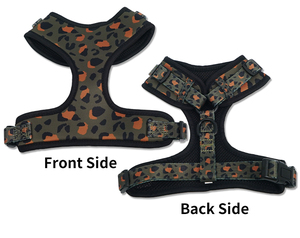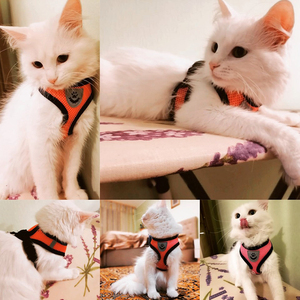(18496 products available)







































































































































































































Designer dog harnesses are fashionable and stylish harnesses for dogs. They come in various designs, colors, and patterns, reflecting a more upscale and trendy appearance. These harnesses are made to help control dogs more effectively and comfortably during walks or activities. Unlike collars, which can put pressure on a dog's neck, harnesses distribute the pulling force across the dog's body, reducing the risk of injury. They often feature adjustable straps, high-quality materials, and unique design elements, making them both functional and visually appealing. There are various kinds of designer dog harnesses:
Vest-style harnesses:
Vest-style harnesses offer a comfortable fit. They are made of soft materials like fabric or neoprene that are gentle on the dog's skin. These harnesses work well for small and medium-sized dogs because they spread out the pressure evenly over the dog's chest and belly. Vest-style harnesses are easy to put on and take off. They usually have adjustable straps on the sides that let you make the harness fit just right for your dog. The design of these harnesses prevents pulling on the neck, making walks more comfortable. They are also good for training because they give the owner better control over the dog. Overall, vest-style harnesses ensure comfort and control for dog owners.
Back-clip harnesses:
Back-clip harnesses are easy to use. They attach the leash to a clip on the back of the harness, making it simple to connect. These harnesses are made so that when a dog pulls on the leash, the pressure goes onto the harness and not their neck. This is safer and more comfortable for the dog. Back-clip harnesses are great for everyday walks and are liked by many pet owners because of their simple design. They are good for dogs who don't pull much on the leash. However, if a dog pulls a lot, a different kind of harness that gives more control might be better. Overall, back-clip harnesses are user-friendly and comfortable for dogs.
Front-clip harnesses:
Front-clip harnesses have the leash attachment clip on the front, right on the dog's chest. This design helps control a dog more than back-clip harnesses. When a dog pulls on the leash, they are turned around a bit towards the owner, which makes it easier to manage their pulling. Front-clip harnesses are good for training because they help teach dogs not to pull on the leash. They also give better control over energetic or large dogs. These harnesses are great for both small and big dogs. They are made to fit comfortably without hurting the dog. Overall, front-clip harnesses are very helpful for training and controlling dogs.
Step-in harnesses:
Step-in harnesses are easy for dogs to put on. The dog puts their front legs into the harness first, and then the owner clips it together on their back or tummy. This makes it simple and quick to get the harness on the dog. Step-in harnesses are comfortable because they fit snugly but not too tightly. They are good for walking dogs without hurting their neck. Step-in harnesses are great for small and medium-sized dogs. They are made with soft materials that are gentle on the dog's skin. Owners like them because they are easy to use. Overall, step-in harnesses are simple and comfortable for both dogs and their owners.
No-pull harnesses:
No-pull harnesses are designed to stop dogs from pulling hard on the leash. When a dog pulls, these harnesses gently push or steer them to the side or back, which helps discourage pulling behavior. No-pull harnesses are great for training because they give better control and help teach dogs not to pull on walks. They are especially useful for big or strong dogs who pull a lot. No-pull harnesses are usually made with adjustable straps so they can fit well. They keep pressure off the dog's neck, making them comfortable to wear. Overall, no-pull harnesses are helpful for training and controlling dogs that pull on the leash.
Vest Harness
This design encompasses the entire torso of the dog with a vest-like structure. This vest distributes the pressure of the leash all over the body; hence it is perfect for small dogs with delicate necks. It is also good for training since it gives more control over the dog. It is best for dogs that pull a lot since it minimizes the risk of injury to the owner and the dog.
Back-Clip Harness
This harness has a D-ring for the leash attachment on the back between the shoulder blades. It is easy to put on and take off, making it ideal for daily walks and active dogs. It is not suitable for training, though, because it does not provide much control.
Front-Clip Harness
This design has a D-ring for the leash attachment on the front of the chest. It is excellent for training and controlling pulling since it turns the dog towards the owner when it pulls. It is also good for stubborn dogs and those who have not yet learned how to walk without pulling on the leash.
No-Pull Harness
These are special harnesses designed for training dogs that pull a lot during walks. Some have a front clip to discourage pulling, while others have an adjustable feature that tightens around the dog's body when it pulls.
Adjustable Harness
Some harnesses have parts that can be adjusted to fit different body sizes. These are good because they can be used by puppies who are still growing or for different dogs of varying sizes.
Materials Used
Some common materials used in making dog harnesses include nylon, leather, and polyester. Nylon and polyester are both light and strong, making them good for active dogs who like playing outdoors. Leather is durable and has a classic look, but it may not be suitable for wet weather conditions. Mesh material is breathable and good for hot weather, while padded materials provide extra comfort for long walks or sensitive dogs.
Large breed dogs:
Large breeds like Alsatians and Labrador retrievers need to go for walks frequently. The dog harnesses for large breeds are the best to use for these kinds of dogs. Their body structure is such that the force exerted on their necks when they pull to run can cause injuries. Large breed dog harnesses distribute the pressure around their body, making it safe and comfortable for them.
Training:
When training dogs, especially young ones, it is important to use a dog harness. A dog harness gives the trainer more control over the movement and behavior of the dog. Harnesses designed with hand grips can be used to guide or correct dogs when they misbehave during training sessions.
Daily exercise:
For daily exercises like jogging or running, a no pull dog harness is a good option to prevent the dog from running ahead or behind the owner. This allows for a better connection between the owner and the pet, as the owner can comfortably direct the dog to follow at a certain pace or run beside them.
Traveling:
When traveling with pets in cars, safety is very important. Dog seat belts are harnesses that are specifically designed to secure dogs while traveling in vehicles. These harnesses will prevent dogs from distracting the driver during the journey. It will also prevent dogs from getting serious injuries that could arise from sudden jerks or accidents.
Assistance dogs:
For assistance dogs like service dogs and therapy dogs, using an assistance travel harness makes it easier for the handler or owner to control the dog. This type of harness has handles that allow the owner to guide the dog properly. It is especially important in public places where service dog teams need to move around without causing disturbance to others.
Cold weather:
In cold weather conditions, insulated harnesses come in handy. These insulated harnesses provide extra warmth and protection against cold temperatures for working dogs like sled dogs or outdoor dogs who perform activities in snowy regions.
Purpose and Usage:
When choosing a dog harness for business purposes, it is important to consider the type of harness that will be most suitable for the dogs. For example, if the harness will be used for small dogs, a small dog harness that is designed to keep small dogs secure and comfortable may be a good option. Alternatively, a large dog harness may be more appropriate for bigger dogs. The purpose of the harness should also be taken into account - whether it is for walking, running, or other activities - as this can affect the type of design and features that are needed.
Size and Fit:
Dog sizes vary, and so do their body shapes. Some dogs have broad chests and slim waists, while others have narrow chests and thick waists. It's essential to take your dog harness size and weight to determine the right fit. Small and medium-sized dogs tend to have adjustable harnesses that fit many sizes. For large dogs, it's best to choose a harness based on the manufacturer's sizing chart. Remember that a good fit should not be too loose or tight; when a dog harness is too loose, it may be ineffective in controlling your pup, and if it's too tight, it may restrict your dog's movement and cause discomfort.
Material and Durability:
Dog harnesses are made from various materials, including nylon, leather, and polyester. Each material has its advantages and disadvantages. For example, leather harnesses are durable and offer a classic look, but they may not be suitable for wet conditions as leather can be damaged by water. Harnesses made from nylon and polyester are lightweight, easy to clean, and water-resistant, making them suitable for various activities and weather conditions. Consider the material and its durability, especially if the harness will be used for active dogs or in outdoor settings.
Features and Adjustability:
Look for features that enhance the comfort and usability of the harness. These may include padded straps, multiple adjustment points, and easy-to-use buckles. Padded straps prevent chafing and pressure points on the dog's body, ensuring a comfortable fit during walks or activities. Multiple adjustment points allow for a customizable fit, accommodating dogs with different body shapes. Easy-to-use buckles make it simple to put on and take off the harness, saving time and effort.
Safety and Security:
Ensure that the harness has sturdy construction and secure fastenings to keep the dog safe during use. Look for reinforced stitching, strong clips, and durable materials that can withstand the dog's strength and prevent accidental escapes. Additionally, consider harnesses with reflective elements or visibility in low-light conditions for added safety during evening walks or early morning outings.
Budget:
Dog harnesses come in various price ranges. Set a budget that considers the quality, features, and durability of the harness. Remember that investing in a well-made harness can provide comfort and safety for the dog in the long run.
Q1: Why are dog harnesses preferred over collars?
A1: Dog harnesses distribute force evenly across the dog's body, reducing the risk of neck injuries compared to collars, especially for energetic dogs.
Q2: What are the signs that a dog harness is too tight?
A2: If the harness leaves red marks on the dog's fur after use, that's a sign it's too tight. Other indications include the dog's discomfort, reluctance to walk, and excessive barking.
Q3: Can dog harnesses be washed?
A3: Yes, most dog harnesses can be machine washed. It's essential to check the care instructions on the harness before washing it.
Q4: Why are designer dog harnesses expensive?
A4: Designer dog harnesses invest in premium materials, unique designs, and the harnesses' brand reputation.
Q5: How can one store a dog harness?
A5: Dog harnesses should be stored in a cool, dry place, away from direct sunlight. They can be hung in a closet or kept in a drawer, ensuring they don't get tangled or dusty.